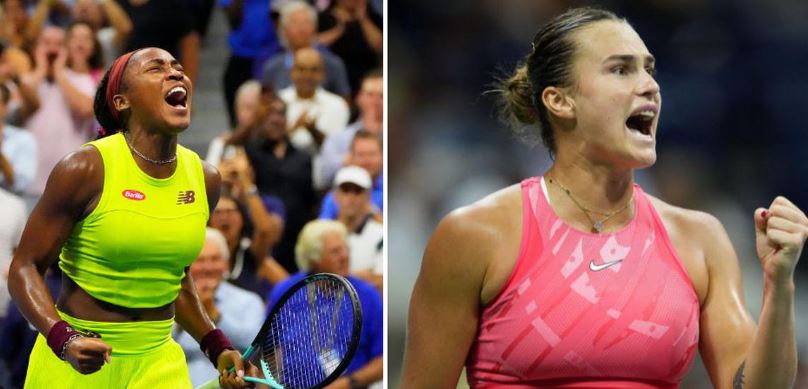These days, kids grow rapidly, and Coco Gauff is no exception.
In early July, she was a tentative tennis youngster probably going into the sport’s wilderness, unable to explain why she was still waiting for her big moment despite having seemed so precocious and destined for greatness.
When September rolls around, she will be the new face of her sport in America as a finalist at the U.S. Open, her home Grand Slam event.
On a hot and humid Thursday night at Arthur Ashe Stadium, the 19-year-old prodigy from sultry South Florida, Gauff, defeated Karolina Muchova of the Czech Republic 6-4, 7-5 to go to her first U.S. Open singles final. The night went Gauff’s way in front of an audience who erupted for her over and over again despite being put to the test like never before by Muchova’s all-court game and the oddest of atmospheres.
Gauff’s final opponent will be Belarus’s Aryna Sabalenka. After a gruelling three-set battle that lasted until almost 1 a.m., it was Sabalenka who emerged victorious over Madison Keys and secured her status as the new world No. 1 in the next rankings. At 5-4 in the second set, and again at the halfway point in the third, Keys had a match point. Sabalenka’s error-ridden power game was just good enough to prevent an all-American final from occurring, though.
Gauff had the match well in hand when a 50-minute delay was imposed at the start of the second set due to a climate protest. Security and the New York Police Department had a difficult time removing protestors from the top level of the stadium because one of them had used adhesive to bind his feet to the pavement.
Gauff was up 6-4, 1-0, and playing well when the match was stopped because Muchova was using tape under her black compression sleeve, which covered her right arm from the biceps to the wrist.
While waiting for the game to start, Gauff and Muchova went to the locker room and the warm-up area to loosen up. After receiving a massage, Muchova went for a quick jog outside the locker area. Gauff, apparently unhinged, ambled up to a USTA employee and bent over to peer at social media posts featuring demonstrators.
She subsequently said that when she woke up on Thursday, the thought of a climate protest breaking out immediately flooded her mind, as it did at the French Open in 2022 and at Wimbledon this year.
Perhaps it was a warning. Perhaps the player had done her research, as she is known for always being well-prepared. She graduated high school on schedule in the spring despite spending her whole high school career on the professional circuit. She and her family celebrated in Paris, and she went on to win six matches in the French Open until losing in the final to the No. 1 player in the world, Iga Swiatek, on a day when she said she was “overwhelmed” by the significance of the occasion.
A year after seeing Serena Williams’s last match, which marked the end of an era for American tennis, a maximum audience of over 24,000 supporters came on Thursday eager to honour a new American tennis queen.
Gauff, who made her debut at Wimbledon when she was 15 and reached the quarterfinals of the French Open last year, has emerged as the frontrunner to fill the hole over the previous four years. Since then, though, her development seemed to halt, particularly on the biggest stages; she had not yet advanced beyond the quarterfinals of the U.S. Open, the event where the spotlight was brightest on her.
Neither this run nor the title that is just one match away seemed likely two months ago, but Gauff provided every explanation for why it is now. She’s always had a lethal serve, a difficult backhand, and the finest court coverage in women’s tennis because to her lightning-fast feet and explosive agility.
In just five weeks, she has mastered their utilisation, and her once-unsteady forehand has become a formidable weapon. Against Muchova, she used both hammering and looping forehands, as well as slicing and hammering serves. She slashed with her backhand and rushed the net. She seized the initiative and battled with Muchova for points until the Czech star squandered them. Her feathery drop shot resulted in the first of her match points.
Midway through the first set, Gauff began to falter and eventually lost the set after leading 5-1 in games. Muchova began to serve aggressively and force Gauff backwards. Gauff was trying to win the match at 5-3 in the second, but she dropped her serve again.
It would take three more games, one more break of Muchova’s serve, five more match points, and an almost unending, lung-busting, 40-shot comeback with a variety of strokes landing only inches from the net and some floating a full ten feet over it.
Gauff had suspicions before to and throughout that crucial juncture in the race. She maintained that she was prepared for such a moment, that she had the necessary stamina and breathing capacity, and that it was only a question of time. As the rallies continued, she realised a victory would shift the outcome of the match and that Muchova wouldn’t be able to withstand another lengthy test on match point.

